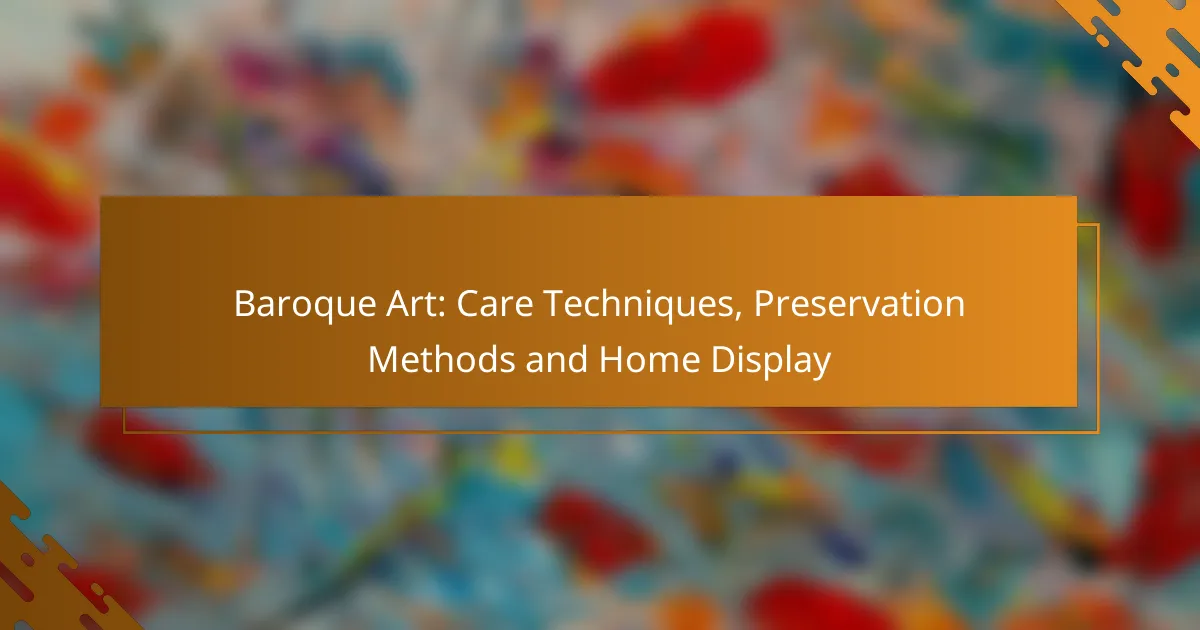Baroque art, known for its intricate details and vibrant colors, requires careful care and preservation techniques to maintain its beauty at home. Regular maintenance, including dusting, humidity control, and appropriate lighting, is essential for protecting these valuable artworks. Additionally, thoughtful display methods can enhance their dramatic qualities while ensuring their longevity for future enjoyment.

How to care for Baroque art at home?
Caring for Baroque art at home involves regular maintenance and environmental control to preserve its intricate details and vibrant colors. Implementing effective dusting, humidity management, temperature regulation, light exposure management, and careful handling will help maintain the artwork’s integrity over time.
Regular dusting techniques
Dusting Baroque art should be done gently and regularly to prevent buildup that can damage the surface. Use a soft, lint-free cloth or a feather duster to carefully remove dust without scratching the artwork.
Avoid using chemical cleaners or abrasive materials, as these can harm the delicate finishes. Instead, consider lightly dampening the cloth with distilled water for more stubborn dust, ensuring it is not wet enough to drip.
Humidity control methods
Maintaining appropriate humidity levels is crucial for preserving Baroque art, ideally between 40% and 60%. High humidity can lead to mold growth, while low humidity may cause cracking and warping.
Using a dehumidifier in damp environments or a humidifier in dry conditions can help regulate humidity. Regularly monitor levels with a hygrometer to ensure they remain stable.
Temperature regulation tips
Baroque art should be kept in a stable temperature environment, ideally between 18°C and 22°C (65°F and 72°F). Fluctuations in temperature can cause materials to expand and contract, leading to damage.
Avoid placing artwork near heat sources like radiators or air conditioning vents. Using a thermostat can help maintain a consistent temperature throughout the year.
Light exposure management
Excessive light exposure can fade the colors and damage the materials of Baroque art. Ideally, artworks should be displayed in areas with controlled lighting, avoiding direct sunlight.
Consider using UV-filtering glass or acrylic for framing, and limit exposure to artificial light sources. Dimmer switches can also help manage light intensity when displaying the artwork.
Handling and transport precautions
When handling Baroque art, always ensure your hands are clean and dry to avoid transferring oils or dirt. Use cotton gloves for added protection, especially when touching the frame or surface.
For transport, wrap the artwork in acid-free materials and secure it in a sturdy container. Avoid stacking items on top of the artwork to prevent pressure damage during transit.

What preservation methods are effective for Baroque art?
Effective preservation methods for Baroque art include careful environmental control, regular cleaning, and appropriate restoration techniques. These methods help maintain the integrity and aesthetic value of artworks from this period, ensuring they remain in good condition for future generations.
Restoration techniques
Restoration techniques for Baroque art focus on repairing and revitalizing damaged pieces while preserving their original character. Common methods include cleaning with gentle solvents, filling in losses with compatible materials, and revarnishing to restore luster. Each technique should be approached with caution to avoid compromising the artwork’s integrity.
For example, using a micro-abrasive system can effectively remove grime without damaging the surface. It’s crucial to document any restoration work to maintain a record of the artwork’s history and changes over time.
Conservation materials and tools
Conservation materials and tools are essential for the preservation of Baroque art. Common materials include archival-quality adhesives, reversible varnishes, and pH-neutral cleaning agents. Tools such as soft brushes, microfiber cloths, and specialized spatulas help conservators work delicately on these valuable pieces.
When selecting materials, ensure they are compatible with the original components of the artwork. For instance, using a solvent that is too harsh can damage the paint layer, while pH-neutral materials help prevent chemical reactions that could lead to deterioration.
Professional services for preservation
Engaging professional services for the preservation of Baroque art is often necessary for significant restoration projects. Trained conservators have the expertise to assess the condition of artworks and recommend appropriate treatments. They can also provide preventive care strategies to avoid future damage.
When seeking professional help, look for conservators with experience in Baroque art and check their credentials. Many institutions offer conservation services, and it is advisable to obtain multiple quotes to understand the scope and cost of the work involved, which can vary widely based on the artwork’s condition and complexity.

How to display Baroque art in your home?
Displaying Baroque art in your home involves careful consideration of lighting, framing, and placement to enhance its dramatic and ornate qualities. Proper techniques can elevate the artwork’s impact and preserve its integrity over time.
Optimal lighting solutions
Lighting plays a crucial role in showcasing Baroque art, emphasizing its rich colors and intricate details. Use soft, diffused lighting to avoid harsh shadows and glare; LED lights with a color temperature around 3000K are often ideal.
Consider adjustable track lighting or wall sconces to highlight specific pieces. Avoid direct sunlight, as it can fade colors and damage the artwork over time. Using UV-filtering glass in windows can help protect your pieces from harmful rays.
Framing options for Baroque paintings
Choosing the right frame for Baroque paintings enhances their grandeur and complements their ornate style. Opt for frames that are gilded or have intricate carvings, as these reflect the opulence of the Baroque period.
Ensure the frame is appropriately sized; it should not overwhelm the artwork but instead enhance its presence. Consider using acid-free materials for matting and backing to prevent deterioration of the painting over time.
Placement strategies for sculptures
When displaying Baroque sculptures, placement is key to ensuring they are appreciated from all angles. Position sculptures on pedestals or in well-lit areas to draw attention and create a focal point in the room.
Keep sculptures away from high-traffic areas to minimize the risk of damage. Consider using a dedicated display case if the sculpture is particularly valuable or fragile, ensuring it remains protected while still visible.

What are the common mistakes in caring for Baroque art?
Common mistakes in caring for Baroque art include improper cleaning techniques, neglecting environmental factors, and using unsuitable materials. These errors can lead to irreversible damage, diminishing the artwork’s value and aesthetic appeal.
Improper cleaning techniques
Using the wrong cleaning methods can harm Baroque art significantly. For instance, abrasive cloths or harsh chemicals can scratch surfaces or strip away delicate finishes. Always opt for soft, lint-free cloths and pH-neutral cleaners specifically designed for art preservation.
Regular dusting is essential, but it should be done gently. A soft brush or a microfiber cloth is ideal for removing dust without causing damage. Avoid using water directly on the artwork, as moisture can lead to mold growth or discoloration.
Neglecting environmental factors
Environmental conditions play a crucial role in the preservation of Baroque art. High humidity can cause mold, while low humidity may lead to cracking and warping. Aim to maintain indoor humidity levels between 40% and 60% for optimal preservation.
Temperature fluctuations can also be detrimental. Keeping artworks in a stable environment, ideally around 20°C to 22°C, helps prevent thermal expansion and contraction that can damage the materials. Avoid placing art near windows or heating vents to minimize exposure to direct sunlight and drafts.
Using unsuitable materials
Using the wrong materials for display or storage can lead to deterioration of Baroque art. For example, avoid plastic frames or storage boxes that can emit harmful chemicals over time. Instead, choose acid-free materials that are safe for long-term preservation.
When mounting or framing, ensure that all materials, including adhesives and backing boards, are archival quality. This will help protect the artwork from degradation and maintain its integrity for future generations.

What are the prerequisites for preserving Baroque art?
Preserving Baroque art requires a thorough understanding of the materials used, as well as the common types of damage these artworks may encounter. Proper environmental conditions, handling techniques, and regular maintenance are essential to ensure their longevity.
Understanding art materials
Baroque art often incorporates a variety of materials, including oil paints, gilded surfaces, and intricate woodwork. Each material has specific care requirements; for instance, oil paints can be sensitive to humidity and temperature fluctuations. Knowing the composition of an artwork helps in selecting appropriate cleaning and preservation methods.
Additionally, many Baroque pieces feature delicate fabrics or varnishes that can degrade over time. It is crucial to avoid harsh chemicals and abrasive tools when cleaning, as these can cause irreversible damage. Instead, use pH-neutral solutions and soft cloths to maintain the integrity of the artwork.
Identifying common damage types
Common damage types in Baroque art include fading, cracking, and flaking of paint, as well as deterioration of gilded surfaces. Fading can occur due to prolonged exposure to sunlight, while cracking often results from fluctuations in temperature and humidity. Regularly inspecting artworks can help identify these issues early.
Flaking paint can be particularly problematic, as it may expose underlying layers to further damage. To prevent this, maintain stable environmental conditions and consider using UV-filtering glass for display. If damage occurs, consult a professional conservator for restoration rather than attempting to fix it yourself, as improper repairs can worsen the situation.

What are the emerging trends in Baroque art preservation?
Emerging trends in Baroque art preservation focus on advanced technologies and sustainable practices. Techniques such as digital imaging, climate control, and conservation-friendly materials are increasingly being adopted to ensure the longevity of these artworks.
Use of Digital Imaging
Digital imaging is becoming a vital tool in the preservation of Baroque art. High-resolution scans and photographs allow conservators to document the condition of artworks accurately and monitor changes over time. This technology also aids in creating virtual exhibitions, making art more accessible to the public.
Sustainable Conservation Materials
There is a growing emphasis on using sustainable materials in the conservation of Baroque artworks. Traditional methods often relied on harmful substances, but modern practices prioritize eco-friendly alternatives that minimize environmental impact. For example, using biodegradable adhesives and non-toxic solvents is becoming standard in restoration efforts.
Climate Control Systems
Implementing advanced climate control systems is crucial for preserving Baroque art. These systems help maintain optimal temperature and humidity levels, which are essential for preventing deterioration. Museums and galleries are increasingly investing in technology that allows for real-time monitoring and adjustments to create a stable environment for these delicate pieces.
Collaboration with Technology Experts
Collaboration between conservators and technology experts is a rising trend in Baroque art preservation. This partnership fosters innovative solutions, such as using artificial intelligence to analyze artworks and predict potential damage. Such interdisciplinary approaches enhance the effectiveness of preservation strategies and ensure that Baroque art remains intact for future generations.



